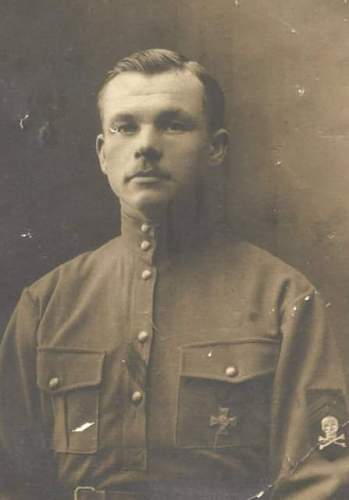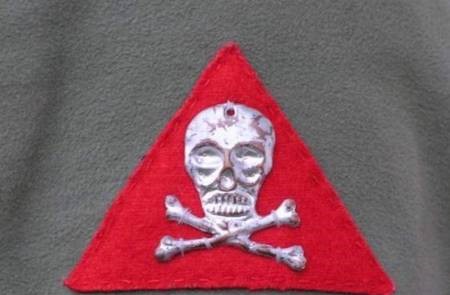skull of legions in Russia, 1st Czechoslovak Assault Battalion
Article about: Red ribbon for Bohemia, skull and crossbones for the death, not life without Czech state, freedom or death." That was the slogan, energy and life philosophy Troopers, which is the name
-
 skull of legions in Russia, 1st Czechoslovak Assault Battalion
skull of legions in Russia, 1st Czechoslovak Assault Battalion
Red ribbon for Bohemia, skull and crossbones for the death, not life without Czech state, freedom or death." That was the slogan, energy and life philosophy Troopers, which is the name for members of the 1st Czechoslovak. separate assault battalion.
At the end of the first world war Czechoslovak legions in Russia has Czechoslovak Army Corps, which was formed three divisions and other departments, most of which dominated the martial arts 1 MS. separate assault battalion in accordance with their slogans "Bohemia for the red and white ribbon, skull and crossbones for the death, not life without Czech state, freedom or death" and "Beat, kill, anyone inanimate". In the spirit of these passwords he expanded power of MS. Legions along the Trans-Siberian Railway northern Eurasia in the years 1918 - 1920. It is this spirit enabled them to dominate large areas and enforce in practice its philosophy, which was - anyone too nepárej problems Res intensively on the spot, or not ask if I ever not worth it.
1 MS. separate assault battalion was established on 28 December 1917. The Czechs, who were previously in the section General Kornilov, became the basis for cadre 1 MS. separate assault battalion, along with other legionnaires who arrived here from the 2nd Division of MS. Legion and being with them to share their experiences of elite units. 1 MS. separate assault battalion existed until his arrival in the country, which in July 1920 was unified in Domažlicích the 6th Border Regiment "Siberian Storm Troopers" and lost its elite character. (General Command of MS. Army had almost sycophantic / profrancouzsky / copied Western Allied armies and did not seek to create their own elite units of value. The ailment could be resolved in the second half of the 30s by creating the so-called. Fast divisions, but it was too late. The same command even rejected the new modern weapons MS. constructors' world-class, again from patolízalských reasons - that our army was armed with better quality than the French, "that the Allies not mind." And this cringing and crawling back before someone takes today ...)
Members of the 1st MS. separate assault battalion were volunteers who had their membership voluntarily chose him with the knowledge that this military unit was deployed at the site of the worst fighting. Commander of the 1st Czechoslovak. assault battalion were gradually Ushakov (died in battle with the Bolsheviks on Baikal in 1918), a pupil Hásek.
1 MS. separate assault battalion suffered its existence to a series victory over the Bolsheviks and their henchmen in the Volga region, Siberia and the Russian Far East. Shock-workers to their membership in the 1st MS. separate assault battalion opted out of love for his nation and homeland (see. Váša Simak from 75 p. pl., whose memories we have cited in Article 75. p. pl. at Zborov, printed in the Special JH no. 6 and 7 ). Shock-workers were mostly people full of optimism and euphoria of the work they perform on the battlefield. This is also evidenced threw program, which was filmed and aired in early '90s (and has since been broadcast ...), where it captured the last living member of the assault battalion, which, despite its age, full of young spirit, energy, joie de vivre , optimism and a smile remembers his 1 MS. commando battalion and combat actions.
One wonders where they took the strength of the Czechoslovak Legionnaires and specially Troopers, which enabled to control such a large area? She was out of love for their homeland! Czech country, old fashioned, called Bohemia, had been until the end of the first world war, than was incorporated on 28 October 1918 the Czechoslovak Republic, part of the multinational Austro-Hungarian Empire. MS. Republic was founded and the Czech nation understood as a renewed independent Czech state. Among both Czechs living in the Czech Republic and beyond, founded in the early 20th century, the desire for a renewed and completely independent Czech state (Czechoslovakia). This desire of the Czech nation was defending not only against Germanization coming from the German-speaking part of the monarchy (of which the total known), but also against balkanization, ie. The dissolution between the two nations, coming from the eastern part of Austria-Hungary (about which much is known). This desire for freedom and self-employed Czech nation had led them to that incurred the Czechoslovak Legion, which fought for these ideals.
After all, our ancestors did not want to be confused and helpless individuals at the mercy of fate (as we do today), and only because of their willingness exists Czech state since the end of the 9th century. If you generalize it has always been our ancestors to preserve his nation and as the best means to preserve it considered the Czech state.
Indeed, thanks to the power to maintain the Czech tradition originated in 883 Czech state and in the following centuries consolidated and strengthened. Thanks to this, it also developed a national revival in the late 18th century. This power allowed our ancestors since the 6th century to live in the center of Europe and enabled to overcome the fault of historical time. Indeed, at the beginning of the state chroniclers wrote neighboring countries to respect the Czech fighters that are wilder than the beasts.
Mentality MS. Legionnaires captures the password you created between MS. Legionnaires in Siberia, which was born in what was then agitated, confused and troubled times of crisis: "In Siberia Bohemia found himself". This password would be explained as confident in their strength, he can only rely on himself and his loved ones, after all, even MS. Legionnaires were calling brothers, which is a nice proof of relations that prevailed between them.
I would like to find out about this badge, which during the Civil War in Russia (1918-1920) wore Czechoslovakia. Legionnaires. Meanwhile, I found that similar skulls at that time and wore various Russian troops fighting against the Bolsheviks (Kornilovci), but the foreign legions had a death head / Adam head in the emblem (except Czech Kornilovcov, who used only Russian versions of skulls) only MS. elite "1st separate strike battalion", which consisted of 4 companies and had only 800 men.
This depicted type of skull, but reportedly wore only the Czechoslovak. Legionnaires, not Russian forces, while some Czech legionnaires wore Russian skulls. If you fix me ...
I would like to learn about this badge as much as possible and therefore I will be very glad for any further information, posts or links on this topic.
I wonder, for example, who could be the manufacturer of this badge and how rare this version. I attach a few period photos of both identical and different versions of these badges.
Thank you in advance for your reactions.









Similar Threads
-
In Polish Armed Forces - Second Republic (Siły Zbrojne II Rzeczypospolitej Polskiej) 1918-1939
-
In Polish Armed Forces - Second Republic (Siły Zbrojne II Rzeczypospolitej Polskiej) 1918-1939
-
In Polish Armed Forces - Second Republic (Siły Zbrojne II Rzeczypospolitej Polskiej) 1918-1939
-
In Polish Armed Forces - Second Republic (Siły Zbrojne II Rzeczypospolitej Polskiej) 1918-1939
-
In Polish Armed Forces - Second Republic (Siły Zbrojne II Rzeczypospolitej Polskiej) 1918-1939
 Posting Permissions
Posting Permissions
- You may not post new threads
- You may not post replies
- You may not post attachments
- You may not edit your posts
-
Forum Rules













 .
.

Bookmarks